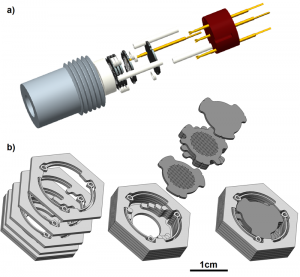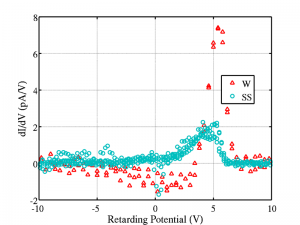Measuring Ion Energy Distribution Using Batch-microfabricated RPAs
- Category: MEMS & BioMEMS
- Tags: akintunde akinwande, eric heubel, luis velasquez-garcia
The need to measure particle energies arises in many applications, from calibrating electron sources for electron guns in precision microscopes to determining the efficiency of space-based ion beam thrusters. Retarding potential analyzers (RPAs) are capable of filtering particles based on their energy and have been used as early as the late 1950s and early 1960s for such purposes [1] . However, these devices maintain limited application due to stringent dimensional constraints driven by plasma Debye length. Cold dense plasmas require minute apertures and tight spacing tolerances between biasing grids that are difficult to enforce using conventional means. We suggest microelectromechanical system (MEMS) batch-fabrication techniques in order to achieve unprecedented alignment accuracy of successive electrodes while incorporating the necessary micron-scale features. Assembly to a precision of a few tens of microns has been demonstrated with a hybrid RPA (see Figure 1a) [2] . Figure 1b shows the fully MEMS-fabricated sensor inspired by in-plane assembly of high-voltage devices, which will have tolerances on the order of 1μm [3] .
Augmenting the optical transparency of RPAs provides a more direct path for particles to the collector plate. Signal strength is thus improved as the effective collection area is increased. Preliminary results and comparisons between MEMS-fabricated electrodes and conventional stainless steel mesh have revealed an ameliorated signal quality. Figure 2 shows a greater than two-fold improvement in peak signal strength with the micromachined grids over the conventional RPA [2] . Currents captured by the various grids and simulations suggest the possibility of ion beam focusing and interception of ions prior to reaching the collector. Alteration of the internal dynamics of the sensor provides a cleaner signal that may lead to a better interpretation of the measurements than with models that incorporated the stochastic behavior of charged species through randomly oriented electrode apertures.
- Figure 1: Exploded views of a) hybrid RPA with stainless steel housing and b) fully micromachined RPA [2] .
- Figure 2: Comparison of ion energy distributions obtained from a 10V ion source with our hybrid sensor showing a more pronounced peak using microfabricated grids over conventional stainless steel mesh [2] .
- W. C. Knudsen, “Evaluation and demonstration of the use of retarding potential analyzers for measuring several ionospheric quantities,” Journal of Geophysical Research, vol. 71, no. 19, pp. 4669–4678, Oct. 1966. [↩]
- E. V. Heubel, A. I. Akinwande, and L. F. Velásquez-García, “MEMS-enabled retarding potential analyzers for hypersonic in-flight plasma diagnostics,” in Proceedings of the 15th Solid-State Sensors, Actuators, and Microsystems Workshop, Hilton Head Is., SC, June 2012, pp. 324–237. [↩] [↩] [↩] [↩]
- B. Gassend, L. F. Velásquez-García, and A. I. Akinwande, “Precision in-plane hand assembly of bulk-microfabricated components for high-voltage MEMS arrays applications,” Journal of Microelectromechanical Systems, vol. 18, no. 2, pp. 332–346, Apr. 2009. [↩]

